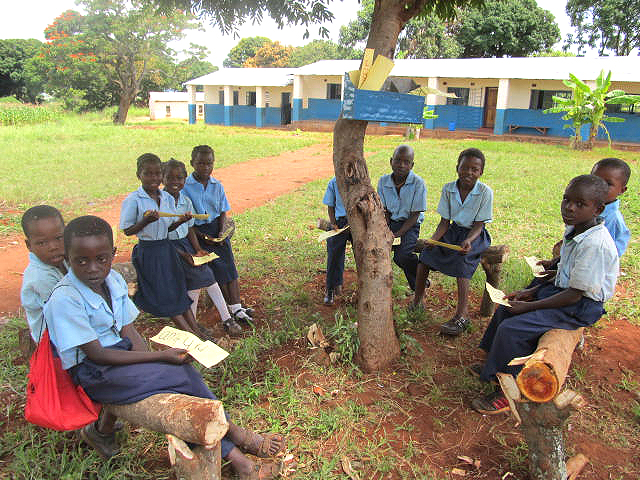In Zambian schools, ‘Books grow on trees’
By Jennifer BrooklandAugust 22, 2013

Under the broad leaves of malaina and makeche trees, students at the Chiparamba basic school in eastern Zambia steal a few moments to do something that used to be almost impossible: read a book.
Many children in Zambia have extremely limited access to reading materials, which are scarce to begin with and are often kept under lock and key by teachers who fear they’ll be taken or damaged.
Even if there were plenty of books, where would students go to enjoy them? Few Zambian schools have any dedicated reading space. With few opportunities to practice reading, many children graduate from Zambia’s government basic schools illiterate.
The students at Chiparamba Basic School have found an imaginative way to make sure that doesn’t happen. With support from the U.S. Agency for International Development’s Zambia Read to Succeed project, they turned shady trees on their school compounds into “reading trees”: wonderful worlds where reading is accessible and fun and books are available to all.
Books are stored in the center of the tree, or hung from a branch during the day and collected at night. Logs, tree stumps and flower pots placed around the tree bear inscriptions for young students to sound out.
“The reading culture has improved,” says first grade teacher Sarah Tongo Phiri. “Instead of depending on formal readers, pupils spend their time out of class in the school walking around from one tree to the other in search of new words or sentences to read from the reading trays that have been affixed on trees.”
At the end of the first term, only 40 of the 150 first graders were able to identify, sound, read and write vowels and syllables. By the end of the third term, 120 of the students could read, write and construct sentences. Phiri attributes her pupils’ progress in reading to the Read to Succeed project.
First grader Paul Mbao did not know any letters when he showed up at school, but he learned to read vowels and began practicing under the reading trees. Now, Paul and his friends spend time together under the trees trying to figure out words and sentences. His parents have been shocked at his progress.
“Reading outside the classroom has really helped these children to improve their reading, because it encourages competition amongst them,” says Phiri. “They find themselves reading around the tree, using the Reading Insakas (huts) and also reading what has been written on objects including reading walls and stumps in the school. The initiative of reading around the tree is really paying off!” she says.
The reading trees have proved to be more than just a space. They have stimulated students’ desire to read and created a culture that fosters success. It is a concept worth replicating according to Head Teacher Adamson Sakala, who says reading trees are easy and fast to implement, cost effective, innovative, fun, and sustainable. Expected to reach 1300 schools, the pilot concept has expanded to two other provinces, where it is taking root.
